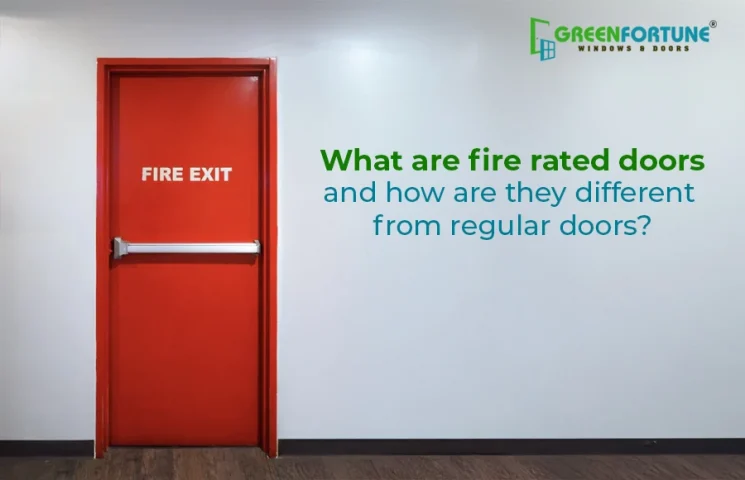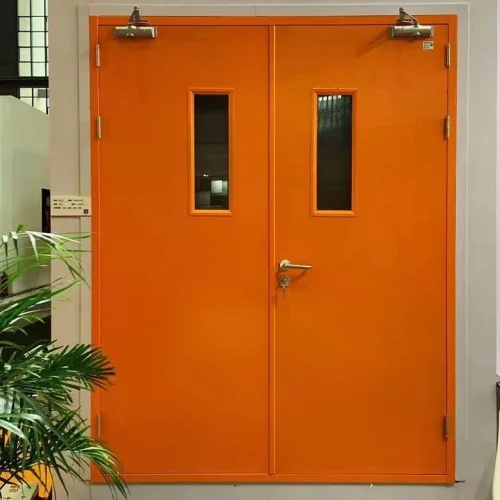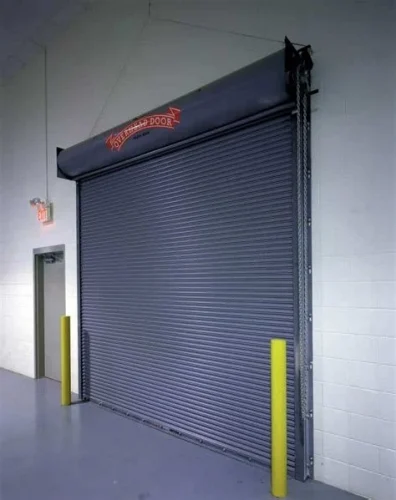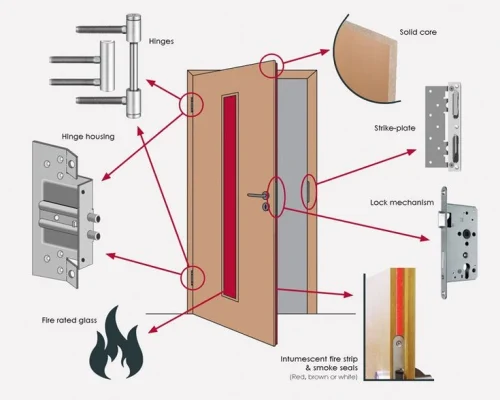
How Biophilic Design Improves the Mental Health of Homeowners
December 27, 2024
Top Kitchen Designs Modular Ideas for a Stylish and Functional Space
December 28, 2024Introduction
Are you trying to understand the difference between fire resistant vs standard doors?
In this blog, we will explore what fire-rated doors are, their components, and how these fire-resistant doors differ from standard doors.
In buildings where safety is a priority, fire rated or fire-resistant doors play a critical role. Fire resistant doors are legally required for safety in all workplaces, commercial buildings, and public spaces. They play an important role in saving lives and protecting property during a fire. Designed to resist the spread of fire and smoke, these specialised doors are essential for enhancing building safety and ensuring compliance with fire safety regulations.
Also read: A complete guide to choosing the perfect aluminium door for your home.
What are Fire Rated Doors?
Fire rated doors are specially engineered to withstand fire for a set duration, such as 20, 60, 90, or even 120 minutes. These doors are rigorously tested and certified based on their fire resistance, which is commonly rated in minutes or hours. The 2-hour fire rated doors, for instance, can withstand fire exposure for up to two hours, making them ideal for high-risk areas.
Key features of fire rated doors:
- Fire doors are made from fire-resistant materials that withstand high temperatures without warping or collapsing.
- They include intumescent seals around the edges that expand when exposed to heat, creating a tight seal between the door and the frame.
- Smoke seals are commonly added to prevent the passage of smoke and toxic fumes.
- Fire rated glass is another option, offering visibility while maintaining fire resistance and compartmental integrity.
- Materials like steel, gypsum, and fire-resistant glass are commonly used in fire door construction.
Source: Pinterest
Components of Fire Rated Doors
Fire rated doors consist of several specialized components that distinguish them from standard doors.
Fire Resistant Materials and Construction
Fire doors are built using materials like steel, hardwood, or fire-resistant glass. These materials ensure the door remains intact during high temperatures.
Fire Rated Hardware
Equipped with fire-rated locks, handles, and hinges, these components are designed to withstand intense heat, ensuring the door stays functional during a fire emergency.
intumescent Seals and Smoke Seals
Fire doors feature intumescent seals around the edges that expand under heat to create a tight seal, preventing fire and smoke from spreading. Smoke seals further block the passage of toxic fumes.
Self-Closing Mechanisms
Fire doors often have self-closing mechanisms, such as door closers or spring hinges, to ensure the door closes automatically, offering additional protection during a fire.
Fire Rated Door Frames
The door frame, often made of steel or hardwood, is crucial for maintaining the door’s fire-resistant properties and structural integrity during intense heat.
Fire Rated Door Glazing
Fire-rated doors may include heat-resistant glass that offers visibility while maintaining safety. This glazing also enhances the door’s aesthetic appeal.
Fire-Resistant vs Standard Doors
Unlike fire-resistant doors, standard doors are designed primarily for entry and exit and lack fire-resistant features. They are typically chosen for their functionality and visual aesthetics rather than safety.
Also read: What are the different types of aluminium windows?
Fire Rated Doors for Garages
Garages often contain flammable materials, making them high-risk areas for fire. Installing fire rated doors for garages ensures an extra layer of protection, preventing the spread of fire to other parts of the building. These doors are typically a part of the firewall system and must comply with local building codes.
Image Source: Pinterest
Fire-resistant vs Standard doors: How they differ
Fire-rated doors and regular doors serve different purposes, with the former designed primarily for safety and the latter for basic functionality and aesthetics.
Material and Construction
Fire rated doors are constructed using specialized materials like steel, gypsum, and treated hardwood. These materials are chosen for their ability to withstand high temperatures without warping, deforming, or losing strength. Some fire rated doors also feature fire-resistant glass that provides visibility while maintaining the safety standards required in fire-prone areas.
In contrast, regular doors are often made from standard materials like untreated wood, composite materials, or basic metals. These materials are not designed to endure extreme heat and may quickly deteriorate in a fire, making them unsuitable for safety-critical applications.
Fire Resistance Certification
One of the key distinctions between fire rated and regular doors is certification. Fire rated doors are rigorously tested to meet safety standards and are labelled with a fire rating that specifies how long the door can withstand fire, such as 30, 60, or 90 minutes. This certification ensures that the door will perform reliably in a fire emergency, providing occupants with valuable time to evacuate and protecting property by containing the fire.
Regular doors, however, lack any certification for fire resistance. They are not designed or tested to hold up against the intense heat of a fire, which makes them a poor choice for areas where fire safety is a concern.
Safety Features
Fire rated doors come equipped with a range of safety features designed to enhance their effectiveness during a fire.
- Intumescent seals are installed around the door edges and expand under high temperatures, creating a tight barrier that prevents fire and smoke from spreading through gaps.
- Many fire rated doors include specially treated glass that maintains its structural integrity during a fire while allowing visibility.
- Components like locks, handles, and hinges are made of heat-resistant materials to ensure that the door remains functional even in extreme temperatures.
In contrast, regular doors lack these critical safety enhancements. They are typically fitted with standard hardware and seals, which are not designed to withstand the stress of a fire.
Application
The intended use of fire rated and regular doors also differs significantly. Fire-rated doors are strategically installed in areas prone to fire risks, such as kitchens, boiler rooms, stairwells, and building exits. Their primary purpose is to contain fire and smoke, allowing safe evacuation and minimizing property damage.
Regular doors, on the other hand, are primarily used for privacy, aesthetics, and functionality. They are commonly found in residential spaces, offices, and other low-risk areas where fire safety is not a primary concern.
Source: Pinterest
Why Invest in Fire Rated Doors?
Fire rated doors provide peace of mind by enhancing the safety of your building.
- Containing flames and smoke in one area.
- Providing critical time for occupants to exit the building.
- Complying with building and fire safety codes.
Also read: Top 10 latest window designs in uPVC windows for your home.
Conclusion
Fire rated doors are not just another safety feature, they are a lifesaving investment. With specialized components like fire rated door frames, fire rated door glazing, and options like 2 hour fire rated doors, these doors provide unmatched protection during a fire emergency. Whether for residential or commercial use, fire rated doors are a smart choice to enhance safety and protect lives.
When selecting fire rated doors, ensure they are certified, meet your specific needs, and are installed correctly for maximum effectiveness.
GreenFortune: Quality uPVC Windows for Your Home
At GreenFortune, we offer top-quality uPVC windows that are both durable and stylish, all at affordable prices. We have a wide range of window designs to suit every home.,
Get in touch to learn more about our uPVC windows. Whether you're renovating your home or building a new one, our windows improve comfort, energy efficiency, and the look of your space.
Frequently Asked Questions (FAQs)
Can fire-rated doors be cut down to size?
Fire-rated doors should not be cut down to size as it can affect their safety and fire resistance. It's best to order the correct size to maintain their effectiveness.
Do all doors need to be fire rated?
Not all doors need to be fire-rated, only those in areas that require extra fire protection, like exits or near hazardous areas. Check local building codes to determine if fire-rated doors are necessary.
Can fire doors be locked?
Fire doors should not be locked while in use, as they need to be easily opened for safety in an emergency. However, they can have automatic release mechanisms or magnetic hold-open devices that unlock during a fire alarm.










